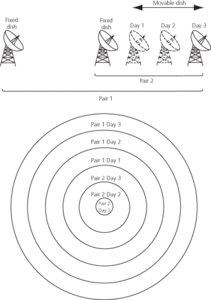See radio telescope.
A technique used in radio astronomy to achieve high angular resolution. It uses an array of telescopes to simulate a single telescope of large aperture (see diagram). In principle, an aperture of any size can be synthesized by moving the two elements of an interferometer to occupy all possible positions in the desired aperture. In practice, all synthesis telescopes make use of the fact that over a period of 12 hours the Earth’s rotation will move the elements to sweep out half a ring of the synthesized aperture (supersynthesis, or Earth-rotation synthesis); the other half of the ring can be derived from the observations of the first half. The elements need then be moved only to sweep out successive rings. In practice, some aperture-synthesis telescopes employ several movable dishes to reduce observing time, while in others the dishes remain fixed (an unfilled aperture). Aperture synthesis requires complex data-reduction techniques and powerful computers. Examples of aperture synthesis telescopes are e-MERLIN, the Karl G. Jansky Very Large Array, and the Westerbork Synthesis Radio Telescope (see Westerbork Radio Observatory).
aperture synthesis:

An aperture synthesis telescope consists of an array of dishes connected in pairs. As the Earth rotates, each pair traces out one ring of a much larger dish, whose diameter is equal to the maximum separation of the pairs. Some of the dishes may be movable, to provide a wider range of separations.